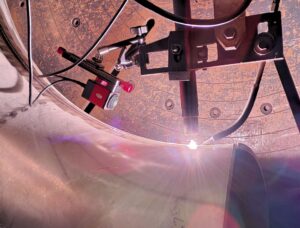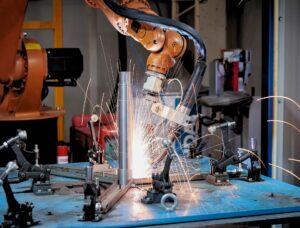Tungsten Inert Gas (TIG) welding is a precise and versatile welding method widely used in industries that demand high-quality welds, such as aerospace. This is where welding cameras come in, enhancing TIG welding precision by providing real-time monitoring and enabling welders to make immediate adjustments. In this blog, we’ll explore how welding cameras improve TIG welding precision in aerospace applications, ensuring higher quality and reduced defects.
1. The Role of TIG Welding in Aerospace Applications
TIG welding is favored in aerospace due to its ability to create clean, high-quality welds with minimal spatter. The process is ideal for welding thin materials such as aluminum, titanium, and stainless steel, which are commonly used in the aerospace industry. TIG welding provides excellent control over the heat input and weld pool, making it perfect for precision applications.
However, achieving this level of precision can be challenging. Especially when working with high-performance materials that require tight tolerances and flawless welds.
Challenges in Aerospace TIG Welding:
- Heat control: Maintaining consistent heat input is critical to avoid warping, cracking, or weakening the weld.
- Material integrity: Aerospace materials must be free from defects like porosity or cracking that could compromise structural strength.
- Precision: Even the smallest deviation in the weld can lead to a compromised part. This affects the safety and performance of the aircraft.
2. Enhancing Precision with Welding Cameras
Welding cameras significantly enhance TIG welding precision by providing real-time visuals of the welding process. These cameras capture high-definition images of the welding arc, the heat-affected zone, and the weld pool. This allows operators to monitor the process closely and make immediate adjustments.
How Welding Cameras Improve Precision:
- Real-Time Monitoring: Welding cameras enable operators to track the welding process in real-time, providing immediate feedback on the arc and weld pool. This ensures that the heat input, arc length, and travel speed remain consistent throughout the process.
- Detailed Arc Visibility: With the ability to capture arc welding images from multiple angles, welding cameras allow welders to observe the welding arc’s behavior and make precise adjustments to maintain a stable arc.
- Reduced Human Error: By providing clear visuals of the welding process, welding cameras reduce the chances of human error, ensuring that the weld parameters are optimized and consistent.
3. Improved Heat Control for Better Weld Quality
One of the key factors that determine TIG welding precision is heat control. Welding cameras help operators maintain consistent heat input by providing clear visibility of the heat-affected zone and the weld pool. This allows welders to adjust the welding parameters to ensure that the right amount of heat is applied, preventing issues like overheating or insufficient fusion.
How It Helps:
- Monitoring Heat Distribution: Welding cameras allow for better monitoring of heat distribution. Thus, helping welders avoid overheating certain areas and ensuring uniform heating throughout the weld.
- Optimizing Travel Speed: By observing the weld pool and heat-affected zone, welding cameras help determine the ideal travel speed for the TIG welding process, ensuring that the weld bead is consistent and free from defects.
- Preventing Overheating and Cracking: Accurate heat control reduces the risk of warping, cracking, or excessive heat buildup. This is crucial in aerospace welding, where material integrity is paramount.
4. Enhanced Detection of Weld Defects
Detecting weld defects like porosity, slag inclusion, or undercut is essential in aerospace applications. Even small flaws can affect the strength and safety of the welded part. Welding cameras provide high-definition images of the weld pool and surrounding area, enabling operators to spot defects early in the welding process.
How It Helps:
- Defect Detection: Welding cameras capture clear visuals of the weld pool and bead. This makes it easier to spot defects such as porosity or inadequate bead formation before they compromise the weld.
- Immediate Adjustments: With real-time feedback, welders can adjust parameters like arc length or travel speed to correct defects as they occur, preventing the need for costly rework.
- Ensuring Weld Integrity: Early detection of defects ensures that the weld meets aerospace quality standards. This provides the strength and durability required for critical components.
5. Reducing Downtime and Rework
In aerospace welding, rework or repairs can be costly and time-consuming. Welding cameras help reduce downtime by enabling immediate troubleshooting and adjustments. This not only improves welding precision but also enhances overall productivity by minimizing delays caused by poor welds or misadjustments.
How It Helps:
- Real-Time Adjustments: Welding cameras allow welders to make real-time adjustments to welding parameters. This prevents defects before they happen and reducing the need for rework.
- Optimizing Welding Parameters: By providing constant visual feedback, welding cameras help optimize parameters such as voltage, amperage, and travel speed. Thus, ensuring that the weld is completed correctly the first time.
- Reducing Inspection Time: Continuous monitoring of the welding process means that inspections can be conducted remotely or in real-time. This reduces the need for physical inspections and minimizing downtime.
6. Remote Monitoring for Increased Efficiency
In large-scale aerospace production, multiple welding stations may need to be monitored simultaneously. Welding cameras provide the ability for remote monitoring, allowing supervisors and operators to observe the welding process from a central location. This enhances efficiency and allows for quick adjustments across multiple workstations.
Efficiency Benefits:
- Centralized Monitoring: Supervisors can monitor multiple welds at once. Thus, ensuring that all welds meet quality standards without needing to be physically present at each station.
- Quick Response to Issues: Welding cameras allow supervisors to detect problems across multiple stations and dispatch corrective actions immediately, reducing the time spent troubleshooting.
- Improved Workflow: Remote monitoring improves the overall workflow by streamlining the inspection process and enabling faster adjustments, leading to a more efficient welding operation.
Conclusion: Achieving TIG Welding Precision in Aerospace with Welding Cameras
While submerged arc welding presents unique challenges due to the flux coverage and heat intensity, TIG welding is an essential technique in aerospace manufacturing, but achieving the precision required for high-quality welds can be challenging. Welding cameras provide a powerful solution to these challenges by offering real-time monitoring, enhanced heat control, and improved defect detection. With clear visuals of the welding process, welding cameras enable welders to make precise adjustments, reduce defects, and ensure that aerospace components meet stringent quality standards.
Whether you are working on aluminum welding, titanium welding, or other aerospace materials, welding cameras can help optimize your welding process and improve the quality of your welds.
Contact Mecaweld today to learn how our welding camera systems can enhance TIG welding precision in aerospace applications.



